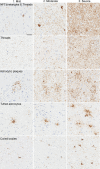Machine learning-based decision tree classifier for the diagnosis of progressive supranuclear palsy and corticobasal degeneration
- PMID: 33763863
- PMCID: PMC9292481
- DOI: 10.1111/nan.12710
Machine learning-based decision tree classifier for the diagnosis of progressive supranuclear palsy and corticobasal degeneration
Abstract
Aims: This study aimed to clarify the different topographical distribution of tau pathology between progressive supranuclear palsy (PSP) and corticobasal degeneration (CBD) and establish a machine learning-based decision tree classifier.
Methods: Paraffin-embedded sections of the temporal cortex, motor cortex, caudate nucleus, globus pallidus, subthalamic nucleus, substantia nigra, red nucleus, and midbrain tectum from 1020 PSP and 199 CBD cases were assessed by phospho-tau immunohistochemistry. The severity of tau lesions (i.e., neurofibrillary tangle, coiled body, tufted astrocyte or astrocytic plaque, and tau threads) was semi-quantitatively scored in each region. Hierarchical cluster analysis was performed using tau pathology scores. A decision tree classifier was made with tau pathology scores using 914 cases. Cross-validation was done using 305 cases. An additional ten cases were used for a validation study.
Results: Cluster analysis displayed two distinct clusters; the first cluster included only CBD, and the other cluster included all PSP and six CBD cases. We built a decision tree, which used only seven decision nodes. The scores of tau threads in the caudate nucleus were the most decisive factor for predicting CBD. In a cross-validation, 302 out of 305 cases were correctly diagnosed. In the pilot validation study, three investigators made a correct diagnosis in all cases using the decision tree.
Conclusion: Regardless of the morphology of astrocytic tau lesions, semi-quantitative tau pathology scores in select brain regions are sufficient to distinguish PSP and CBD. The decision tree simplifies neuropathologic differential diagnosis of PSP and CBD.
Keywords: Machine learning; corticobasal degeneration; corticobasal syndrome; decision tree classifier; hierarchical cluster analysis; progressive supranuclear palsy.
© 2021 The Authors. Neuropathology and Applied Neurobiology published by John Wiley & Sons Ltd on behalf of British Neuropathological Society.
Figures




Similar articles
-
Case report of a patient with unclassified tauopathy with molecular and neuropathological features of both progressive supranuclear palsy and corticobasal degeneration.Acta Neuropathol Commun. 2023 Jun 1;11(1):88. doi: 10.1186/s40478-023-01584-z. Acta Neuropathol Commun. 2023. PMID: 37264457 Free PMC article.
-
Corticobasal degeneration with TDP-43 pathology presenting with progressive supranuclear palsy syndrome: a distinct clinicopathologic subtype.Acta Neuropathol. 2018 Sep;136(3):389-404. doi: 10.1007/s00401-018-1878-z. Epub 2018 Jun 20. Acta Neuropathol. 2018. PMID: 29926172 Free PMC article.
-
Contribution of the astrocytic tau pathology to synapse loss in progressive supranuclear palsy and corticobasal degeneration.Brain Pathol. 2021 Jul;31(4):e12914. doi: 10.1111/bpa.12914. Epub 2020 Dec 29. Brain Pathol. 2021. PMID: 33089580 Free PMC article.
-
Chameleons and mimics: Progressive supranuclear palsy and corticobasal degeneration.Neuropathology. 2020 Feb;40(1):57-67. doi: 10.1111/neup.12590. Epub 2019 Sep 12. Neuropathology. 2020. PMID: 31515852 Review.
-
Astrocytic inclusions in progressive supranuclear palsy and corticobasal degeneration.Neuropathology. 2014 Dec;34(6):555-70. doi: 10.1111/neup.12143. Epub 2014 Aug 14. Neuropathology. 2014. PMID: 25124031 Review.
Cited by
-
Predictive value of machine learning models for lymph node metastasis in gastric cancer: A two-center study.World J Gastrointest Surg. 2024 Jan 27;16(1):85-94. doi: 10.4240/wjgs.v16.i1.85. World J Gastrointest Surg. 2024. Retraction in: World J Gastrointest Surg. 2025 Jan 27;17(1):101330. doi: 10.4240/wjgs.v17.i1.101330. PMID: 38328326 Free PMC article. Retracted.
-
Case report of a patient with unclassified tauopathy with molecular and neuropathological features of both progressive supranuclear palsy and corticobasal degeneration.Acta Neuropathol Commun. 2023 Jun 1;11(1):88. doi: 10.1186/s40478-023-01584-z. Acta Neuropathol Commun. 2023. PMID: 37264457 Free PMC article.
-
Comparison of Machine Learning and Logic Regression Algorithms for Predicting Lymph Node Metastasis in Patients with Gastric Cancer: A two-Center Study.Technol Cancer Res Treat. 2024 Jan-Dec;23:15330338231222331. doi: 10.1177/15330338231222331. Technol Cancer Res Treat. 2024. PMID: 38190617 Free PMC article.
-
Multiple-model machine learning identifies potential functional genes in dilated cardiomyopathy.Front Cardiovasc Med. 2023 Jan 11;9:1044443. doi: 10.3389/fcvm.2022.1044443. eCollection 2022. Front Cardiovasc Med. 2023. PMID: 36712235 Free PMC article.
-
Concurrent tau pathologies in frontotemporal lobar degeneration with TDP-43 pathology.Neuropathol Appl Neurobiol. 2022 Feb;48(2):e12778. doi: 10.1111/nan.12778. Epub 2021 Dec 10. Neuropathol Appl Neurobiol. 2022. PMID: 34823271 Free PMC article.
References
-
- Steele JC, Richardson JC, Olszewski J. Progressive supranuclear palsy. A heterogeneous degeneration involving the brain stem, basal ganglia and cerebellum with vertical gaze and pseudobulbar palsy, nuchal dystonia and dementia. Arch Neurol. 1964;10:333‐359. - PubMed
-
- Dickson DW, Bergeron C, Chin SS, et al. Office of rare diseases neuropathologic criteria for corticobasal degeneration. J Neuropathol Exp Neurol. 2002;61:935‐946. - PubMed
Publication types
MeSH terms
Substances
Grants and funding
LinkOut - more resources
Full Text Sources
Other Literature Sources
Medical
Miscellaneous

